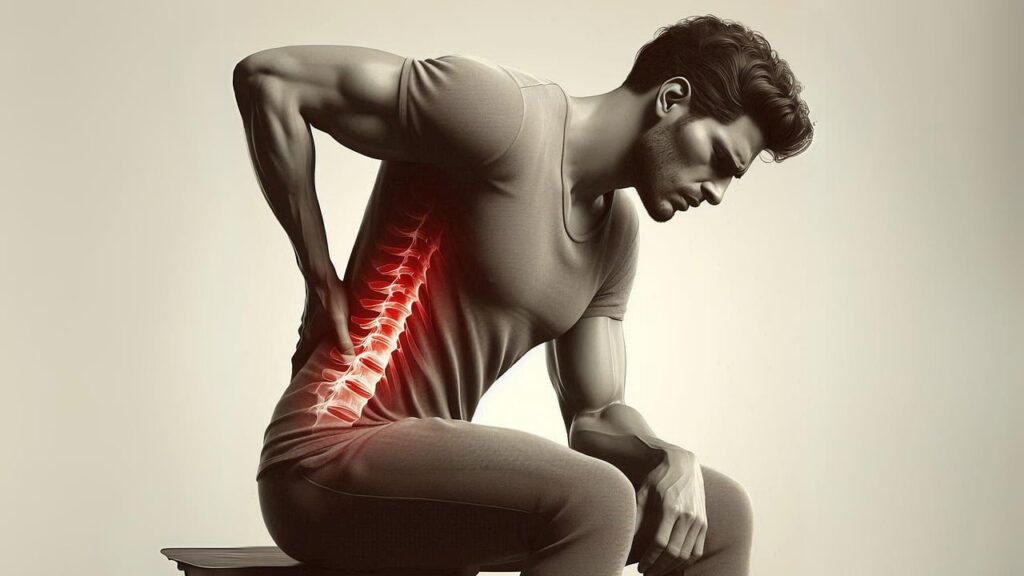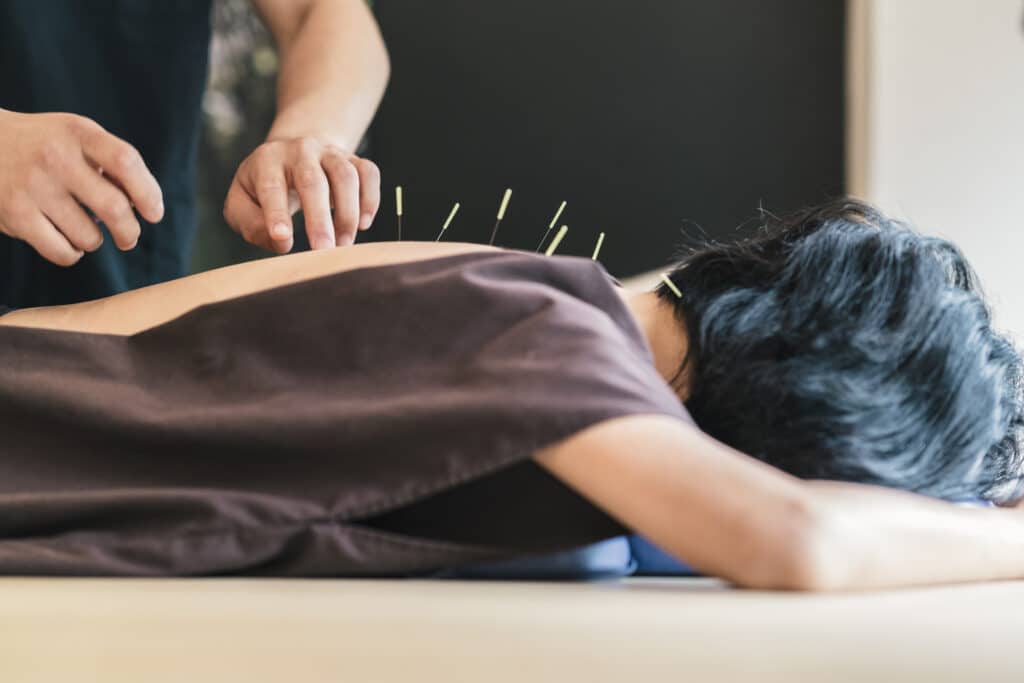Table of Contents
Introduction to Back Pain Clinics
When dealing with back pain treatments in Edmonton, Alberta, it’s crucial to consider several factors to alleviate discomfort and promote healing. The first step is obtaining a precise diagnosis, which is a roadmap for effective treatment and successful outcomes. Back pain can stem from various causes, and a healthcare professional with the necessary expertise can perform a differential diagnosis to identify the specific source of the discomfort. Their guidance is essential for choosing the most effective treatment.
Common Causes of Back Pain
- Muscle strain or sprain
- Herniated or bulging discs
- Arthritis
- Osteoporosis
- Sciatica
- Spinal stenosis
- Skeletal irregularities, such as scoliosis
- Infections
- Tumors
- Kidney stones or infections

Muscular vs. Spinal Back Pain
For most back pain cases, the key factor is distinguishing between muscular back pain and spinal back pain. This differentiation is crucial, as it directly guides the choice of treatment and management. Seeking a comprehensive evaluation and accurate diagnosis from a healthcare provider is essential for effectively managing back pain.
Muscular Back Pain
Muscular back pain typically involves discomfort originating from the back muscles, often due to strain or overuse. There are two primary types of muscular pain:
- Chronic Muscular Back Pain:
This pain persists for months or years, often with ups and downs. It may feel like a dull ache or soreness and can cause stiffness in the morning, difficulty bending, or pain when lying down. Exercise and stretches are often effective in relieving chronic back pain. - Acute Muscular Back Pain:
This pain occurs suddenly, usually following a bad movement or injury. It is severe, very painful, and limiting. Acute back pain is often accompanied by muscle spasms and stiffness, which may even result in temporary bedriddenness. Rest is typically recommended, as certain movements can aggravate the spasms. Chronic muscle pain, if left untreated, can worsen and develop into acute back pain or, in severe cases, spinal back pain.
Spine-Related Back Pain
Spine-related back pain, on the other hand, originates from issues within the spinal column, such as herniated or bulging discs, arthritis, or spinal stenosis. This pain is caused by nerve pressure and may radiate to the buttocks and legs.
While treatable, spine-related back pain is often irreversible, meaning the affected disc or spine area will remain vulnerable. This type of pain is typically more intense and sharp and may radiate into the legs and feet. Other associated symptoms include:
- Tingling or numbness in the legs
- A sensation of heat or cold in the affected area
- Muscle weakness
Why Differentiation is Important
Distinguishing between muscular and spinal back pain ensures appropriate treatment and management. A proper diagnosis from a healthcare professional is crucial to identifying the underlying cause and determining the most effective course of action for relief and recovery.

How to Approach Back Pain
Effectively managing back pain starts with understanding its origin and taking a proactive approach to alleviate discomfort. Here’s how to assess and address back pain:
- Origin:
Assess whether the pain is muscular or spinal. Identifying the source of discomfort is essential for determining the appropriate treatment. - Severity:
If the pain is mild, self-care measures such as rest, gentle stretching, and light exercises can help manage the discomfort. Taking control early can make a significant difference in pain management. - Activities:
Consider which movements or activities exacerbate the pain. Avoid strenuous activities and focus on maintaining proper posture to reduce strain on your back. - Duration:
Acute back pain usually improves within a few weeks with appropriate self-care. Chronic pain, on the other hand, may require ongoing management and professional intervention. - Lifestyle:
Evaluate your daily habits and work environment. Poor ergonomics, sedentary behavior, or unhealthy habits may contribute to back pain. Adjusting your workspace, maintaining an active lifestyle, and practicing good posture can aid in long-term relief. - Medical History:
Reflect on previous injuries, medical conditions, or surgeries that might be related to your back pain. Sharing this information with healthcare providers is vital for an accurate diagnosis and treatment plan.
By considering these factors, individuals can make informed decisions about managing back pain and seeking professional care when necessary.

The Six Best Treatments for Back Pain and Their Advantages
1. Acupuncture for Back Pain
Acupuncture is recommended for most types of back pain, whether muscular, caused by herniated or bulging discs, arthritis, or chronic and acute inflammation. For acute conditions, distal treatment is often preferred, avoiding needles directly in spasmed muscles. Using the Balance Method, acupuncture often delivers immediate results.
2. Chiropractic for Back Pain
Chiropractic adjustments are beneficial for spinal issues, quickly realigning vertebrae. While effective, the adjustments may feel intense for some and could leave residual discomfort. Chiropractic treatment can provide immediate relief if the spine is misaligned. However, it is not recommended for older individuals or those with fragile spines, as manipulation can worsen certain conditions. Softening muscles through warming or massage is often recommended before adjustments.
3. Osteopathy for Back Pain
Osteopathy focuses on joints, fascia, and muscles and is often viewed as a blend of massage and chiropractic techniques. These treatments are typically gentler, more holistic, and longer than chiropractic sessions. Osteopathy is recommended for chronic pain, posture correction, and addressing misaligned ribs or vertebrae.
4. Physiotherapy for Back Pain
Physiotherapy emphasizes self-correction through guided exercises and movement habits. It is particularly effective for rehabilitation and recovery from injuries. Physiotherapy is often combined with other treatments and is suitable for addressing most back pain.
5. Massage Therapy for Back Pain
Massage therapy is excellent for relaxation and is particularly effective for muscular back pain. It is widely accessible and easy to find a therapist. However, those with herniated or bulging discs should exercise caution, as overly strong pressure on the spine can worsen the condition. It’s advisable to work with the same registered massage therapist (RMT) rather than rotating between practitioners.
6. Surgery for Back Pain (In Severe Cases)
Surgery is a last resort, recommended only for acute cases where multiple non-invasive treatments have failed to provide relief. While surgery can offer a solution, it carries risks of unrepairable damage. Recovery should be supported with complementary therapies and exercises to ensure long-term results.

Self-Treatment for Back Pain
Exercise plays a vital role in back pain management. Strong, flexible muscles, good posture, and healthy lifestyle habits are essential for preventing and alleviating back pain.
“The most crucial principle in back pain management is to prevent the aggravation of muscular back pain into sciatic pain.”
This progression is irreversible and can significantly affect daily life. People with muscular back pain must take proactive steps, such as exercise and appropriate treatments, to fix the pain and maintain long-term health.
Back Exercises for Acute Pain
- Relaxation: Rest, lie down, and consider taking a hot bath to relieve tension.
- Medication: Pain medication, when prescribed by a medical doctor, can be helpful for a few days. However, long-term use of pain medication can carry risks.
- Stretching: Gentle, light stretching is recommended, but avoid strengthening exercises during acute pain phases.
Back Exercises for Chronic Pain
- Movement: Any activity that doesn’t exacerbate pain is encouraged.
- Strengthening: Focus on strengthening core muscles, including the abs, lower back, and legs.
- Stretching: Regularly stretch the lower back and Psoas muscles to improve flexibility.
Low-Impact Cardio for Back Pain
Low-impact exercises are highly beneficial for individuals with back pain. Recommended activities include:
- Swimming
- Stationary biking
- Rowing
- Using an elliptical trainer
Walking can be effective for some, but activities like running or playing high-impact sports may worsen back pain. It’s advisable to combine different types of exercises to reduce repetitive strain on the back, hips, and knees.
If you’re unsure which physical activities are best for your condition, consult a healthcare professional for tailored advice

Six Best Back Pain Treatment Clinics in Edmonton, Alberta
When choosing back pain treatments, deciding which methods you want to explore is essential. Combining one to three treatment methods is recommended, as using more than three simultaneously can overwhelm the body. Edmonton offers many excellent clinics for back pain. The following list is based on personal experiences and recommendations, and we will strive to keep it updated over time. Building a personal connection and trust with your therapist is equally important.
1. Rebalance Acupuncture Edmonton
Rebalance Acupuncture uses Balanced Methods acupuncture, often delivering immediate relief from pain, making it clear whether the treatment can help you. Other techniques offered include electro-acupuncture, cupping, herbal therapy, and exercise recommendations. Elad Shalev, Dr. Ac., has been practicing acupuncture since 2004.
2. Leverage Health Chiropractic
Located in West Edmonton, this clinic provides chiropractic treatments. Dr. Dan Levi has been practicing since 2006. The clinic also offers massage therapy, foot biomechanics, and orthotic therapy.
3. Enhanced Health & Wellness
This clinic provides both chiropractic and physiotherapy services, located in South Edmonton.
4. Integrated therapy massage
This clinic offers massage therapy services and yoga classes. They have two locations in South and West Edmonton.
5. Integral Physiotherapy
Integral Physiotherapy consists of a team of experienced physiotherapists who provide a wide range of treatments, including physiotherapy, IMS (Intramuscular Stimulation), spinal decompression, shockwave therapy, and concussion management programs.
6. Spine Assessment Clinic
Located in the Kaye Edmonton Clinic as part of Alberta Health Services, this chronic spine assessment clinic evaluates whether surgery is warranted. Note that the clinic does not offer conservative treatment; patients must trial conservative methods for at least three months before a referral.

We hope you feel better soon.
If you’re unsure which treatment is best for your back pain, please use the form below to contact us for personalized advice.


